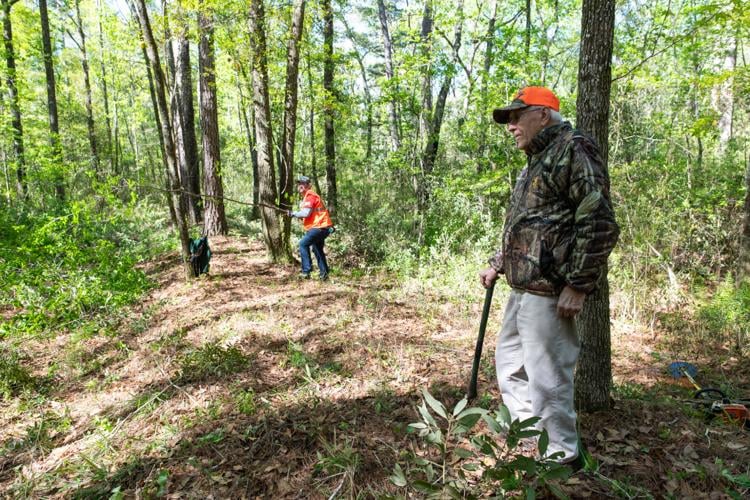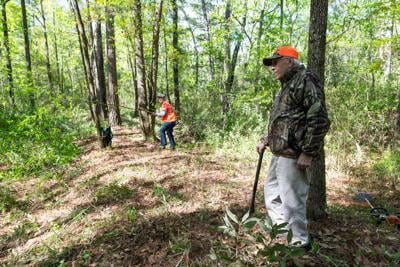RIDGELAND — Cathy DeCourcy, treasurer of the Friends of Honey Hill Battlefield, zipped around the location of the 1864 battle behind the wheel of a side-by-side ATV, delivering water, snacks and encouragement to the teams of volunteers dispersed across the 75-acre site on a bright spring morning.
Her clothes were still a little wet from a spill she took in a creek earlier in the morning, but slipping into the cold, tea-colored water didn’t dampen her spirit or her drive. There was work to be done — a lot of work.
“There is something you get out of going to a battlefield or another historic site that you can never get from the finest documentary or feature film,” said Mary Koik, director of communication for the American Battlefield Trust. “There is something more profound about being there.”
Volunteers were out in force that Saturday morning using rakes, shovels, axes and chainsaws to uncover the remnants of the Civil War battlefield with the ultimate goal of opening the site to public access.
The first phase of the plan for developing the site is expected to cost about $1.2 million and will include an information kiosk, a parking area, interpretive signs, walking trails around the earthworks, a covered pavilion and restrooms.
It would also include an elevated platform that would allow visitors to experience the perspective of the Confederate defenders as they looked downslope from the high ground at the attacking Union forces.

Glass bottles found during an initiative to restore Honey Hill Battlefield in Ridgeland and open it to the public initiated by the Friends of Honey Hill Battlefield. The bottles were not believed to be from the Civil War era.
Even without the platform in place, standing at that site today reveals the challenge Union soldiers faced as they attacked the Confederate position. The Confederates had a commanding view and a clear field of fire. The view is sobering. It must have been a killing field.
The battlefield
An important story is hidden among a nondescript patch of woods that is, when seen from SC Highway 336, indistinguishable from any other stand of trees in the Lowcountry.
Just a few yards away from the rural highway, even an untrained eye will start to notice features among the trees that aren’t natural. Mounds of earthworks several feet high wind through the woods, the remains of the defenses constructed by Confederate soldiers in anticipation of an attack by Union forces.
DeCourcy stopped her ATV on a narrow, sandy track that has existed for three centuries, maybe more, and bushwhacked through 100 feet of dense growth to reach one of the crews working that Saturday morning. They were clearing growth from the remains of a dike that once formed an edge to a rice field, and she was impressed with the progress.
At one point during the Battle of Honey Hill, Confederate forces were positioned on the west side of the dike, using its raised position to defend against the Union advance. Later, as Union forces approached from the east, the Confederates fell back, and Union soldiers sought refuge on the dike’s eastern side. The site, she said, saw a lot of action.
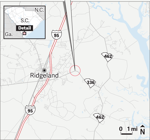
BATTLE OF HONEY HILLL: The Friends of Honey Hill are clearing the site of the Battle of Honey Hill and plan to open it for public access.
“From what we can tell from contemporaneous documents at the time of the battle, (the site) looked very much the same as it does today,” said Richard Thomas, president of the Friends of Honey Hill Battlefield.
The attack expected by the Confederates did come. On Nov. 30, 1864, the Battle of Honey Hill raged for several hours on a sunny and unseasonably mild fall afternoon, said Stephen Wise, professor of history at University of South Carolina Beaufort. Several thousand Union soldiers, sailors and Marines slugged it out with a stubborn Confederate defense in an attempt to cut the rail line connecting Savannah and Charleston.
Setting the stage
In late 1864, Gen. William T. Sherman was marching east from Atlanta toward Savannah. Ahead of his arrival, he requested that the Union’s Department of the South, which was headquartered at the time on Hilton Head Island, initiate an action to sever the railway by Dec. 1. Sherman said he’d be in Savannah by the end of November.
“This was meant as a preventative measure to create a barrier to keep (the Confederates) from transferring reinforcements quickly from Charleston to Savannah,” Thomas said.
Sherman’s request set the stage for the Battle of Honey Hill.
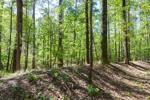
From this position, Confederate forces defended against a Union attack intent on cutting the rail line connecting Savannah and Charleston during the Battle of Honey Hill in November 1864. Plans for restoration of the battlefield include an elevated platform at this location to give visitors a view of the battle from the perspective of the Confederate defenders.
About 5,000 federal forces sailed out of Hilton Head on Nov. 28, up the Broad River toward Boyd Landing in preparation for the action. They ran into problems from the outset. Bad weather delayed their landing, while a bad map cost them precious time as they tried to advance toward the railway.
“They had a faulty map,” explained Wise. “It showed a road that didn’t exist. They lost a whole day trying find the correct road.”
That delay might have been the difference between victory and defeat for the Union Army. In their book, “Rebellion, Reconstruction and Redemption 1861-1893: The History of Beaufort County, South Carolina, Volume 2,” Wise and co-author Lawrence Rowland argue that had the federal soldiers not been delayed, the Union Army would have reached the Confederate defenses while they were still lightly manned. Instead, the Confederates were afforded the time to “create a formidable defense.”
Thomas added that had the Union been successful and taken the rail line out of service, thousands of Confederate troops would have been trapped in Savannah. The war might have ended sooner.
A new Union army
The Union Army sent into battle was a blend of Black and White units, and for the first time the number of Black regiments outnumbered the White regiments.
“That usually did not happen, but here in the Department of the South, they would mix them up. At the Battle of Honey Hill, you had an equal number of Black and White soldiers fighting on the Northern side,” Wise said.
It was a turning point for Black soldiers in the Civil War.

Union forces marched up this Colonial-era stagecoach road when they attacked the Confederate position during the Battle of Honey Hill in November 1864. The Confederate forces successfully defended the position and kept the Union from achieving its goal of cutting the railway connecting Savannah and Charleston.
“There was a growing realization among the Union high command of the value of the Black troops in combat,” Thomas said. “This battle marks the final emergence of the African American fighting man.”
Most of the fight happened during the afternoon hours of Nov. 30. Union forces advanced up a stagecoach road — still clearly visible today — until they came within range of Confederate artillery mounted on top of a ridge. After repeated assaults, the Union was unable to dislodge the Confederate troops, and with daylight fading, the Union withdrew from the field.
“The defenses were well positioned and well constructed, and the Confederates did get reinforcements into the area,” Wise said.
The carnage left in the wake of the Union withdrawal was shocking, even to those used to battlefield scenes after three years of war. In some places, bodies lay five deep. The exact numbers vary, but Wise and Rowland peg Union fatalities at 100, with 610 wounded. Confederate losses were much lighter, with the number of those killed or wounded estimated at about 200. Despite soundly defeating Union forces, the Confederates opted not to pursue the retreating troops.
Within days of the battle, Thomas said, Confederate troops abandoned their defenses at Honey Hill to concentrate their forces ahead of the Battle of Tulifinny.
The restoration
After the Union withdrawal, the Honey Hill Battlefield was mostly quiet for the next 160 years.
“This place has been dormant since Nov. 30, 1864,” said longtime Jasper County resident Milton Woods. “There was some logging in this area at one time, but it’s just been sitting. It was part of Good Hope Plantation.”
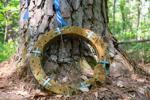
A memorial was left at Honey Hill Battlefield by the descendants of a man who died in the battle.
Good Hope Plantation deeded 238 acres to the Town of Ridgeland in 2009. Later, the town engaged the South Carolina Battleground Preservation Trust to protect the site.
The Friends of Honey Hill Battlefield acts as the preservation trust’s local agent. A conservation easement was put in place to protect 75 acres of the battlefield.
“The primary effort is to preserve the earthworks and other visible signs of what took place,” said Rick Wise, interim executive director of the South Carolina Battleground Preservation Trust. “People drive past a mound of dirt every day in the Lowcountry and not realized its historical significance. All it takes is one bulldozer to remove that forever.”
The Friends of Honey Hill Battlefield linked up with the South Carolina Battleground Preservation Trust sometime before the trust formalized its role with the Town of Ridgeland, and they began to try to generate interest in the restoration of the battlefield, which didn’t come easily at first.
“We had several years where we were spinning our wheels, trying to gain support,” Thomas said. “It takes time.”
Starting last fall, volunteers starting showing up on weekends to clear the overgrown areas by hand. An accommodations tax grant paid for a contractor to come out with some trail-clearing machinery, though the earthworks can only be cleaned up by hand. A local Boy Scout troop and the Parris Island Young Marines have donated time and energy to the initiative.
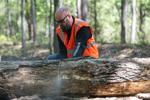
Raymond Sawejko volunteers along the Parris Island Young Marines in an effort to clear the Honey Hill Battlefield in Ridgeland, April 6, 2024.
Moving forward, Thomas hopes to add another 50 acres to the battlefield conservation easement, creating a 125-acre battlefield park and 100 acres of a nature preserve.
“You’d have the two sides more or less connected; somebody could come in and go to one or the other,” Thomas said.
Additional plans for the site have a more serious tenor. No clear records exist indicating where those killed in the battle where buried, and a couple of dozen Union soldiers were never recovered. There is a belief among those working the site that the bodies may still be somewhere on the battlefield, and tentative plans to bring in cadaver dogs to search for human remains are in the works.
Thomas said several grant applications currently are being considered.
“If we can get everything that we’ve asked for, the total is about $900,000, which would allow us to do a lot of Phase 1 work on the battlefield,” he said. We could complete that in about 18 months. At that time, we’d be ready to begin guided tours on a scheduled basis.”
Other worldly
After discussing history, military strategy and fundraising for three hours, the talk eased and turned to battlefield ghosts. Woods explained that not all of the battlefield is on town property. Some of it remains in private hands. Then he relayed a story told to him by a private landowner who claimed he saw a figure walking along the earthworks on his property not once, but twice.
“You know, Dennis Averkin has a ghost story about Honey Hill,” DeCourcy remarked offhandedly.

Confederate forces used these earthworks to repel multiple Union Army attacks intent on cutting the railway connection Charleston and Savannah during the Battle of Honey Hill in November 1864. An initiative by the Friends of Honey Hill Battlefield is underway to restore the battlefield site and open it to the public.
Averkin is Ridgeland town manager, and an email inquiry from The Post and Courier asking about his experience received a prompt response.
He did indeed have a ghost story about Honey Hill, and it closely matched the story Woods had heard.
As Averkin tells the tale, he and his son were inspecting the site in the aftermath of Hurricane Matthew when his son noticed someone dressed in gray who appeared to be walking along the top of the earthworks. Averkin saw the figure, too, which walked 10 steps in one direction, turned, and walked 10 steps in the opposite direction. Unsure of what they beheld, Averkin and his son moved closer, only to find they were alone in the forest. No footprints in the soft dirt betrayed the presence of another living being.
“We both felt goosebumps on our arms,” Averkin wrote. “We were both experiencing what I would call a very uneasy, almost nauseous feeling as we walked out of the battlefield. It was very odd.”
DeCourcy calls Honey Hill Battlefield “Jasper County’s diamond in the rough.” The spirits that haunt it have had the run of the place for more than a century and a half. In the coming years, it’s likely that they’re going to have much more company.
“What can take place on this 238 acres is only limited by what the mind can visualize,” Woods said. “The stories have never been fully told from a historical perspective. Now, the story’s going to get told.”

